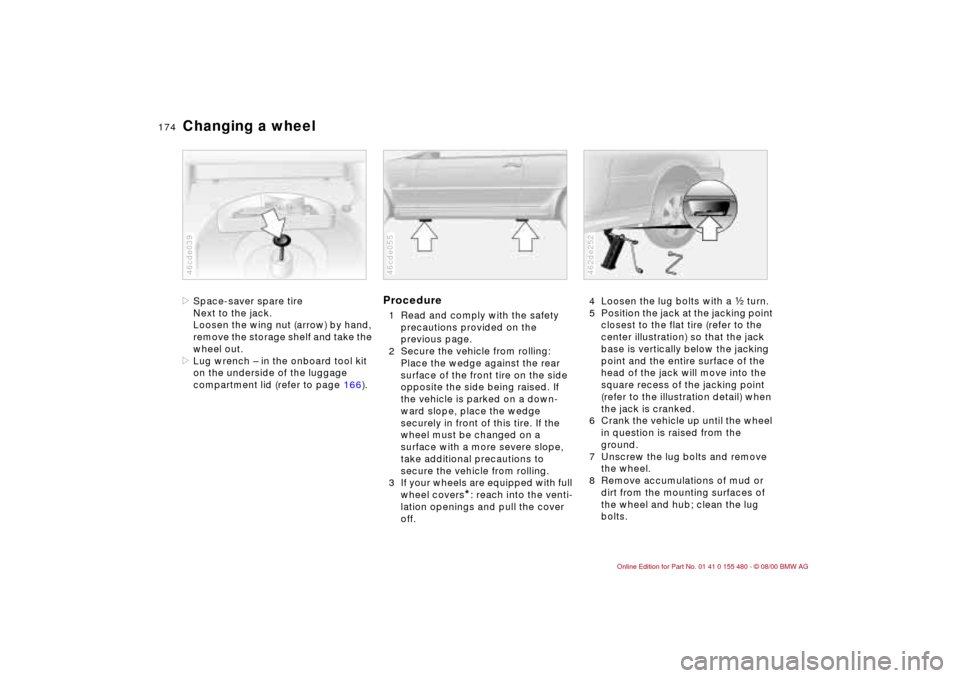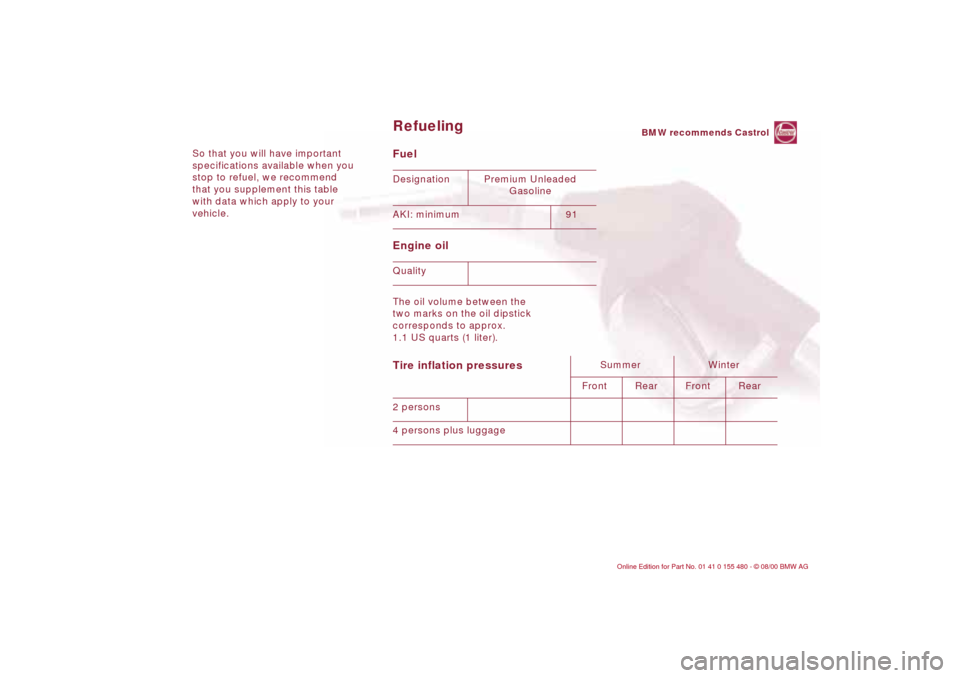2001 BMW 325Ci CONVERTIBLE flat tire
[x] Cancel search: flat tirePage 174 of 215

174n
Changing a wheel>Space-saver spare tire
Next to the jack.
Loosen the wing nut (arrow) by hand,
remove the storage shelf and take the
wheel out.
>Lug wrench Ð in the onboard tool kit
on the underside of the luggage
compartment lid (refer to page 166).46cde039
Procedure1 Read and comply with the safety
precautions provided on the
previous page.
2 Secure the vehicle from rolling:
Place the wedge against the rear
surface of the front tire on the side
opposite the side being raised. If
the vehicle is parked on a down-
ward slope, place the wedge
securely in front of this tire. If the
wheel must be changed on a
surface with a more severe slope,
take additional precautions to
secure the vehicle from rolling.
3 If your wheels are equipped with full
wheel covers
*: reach into the venti-
lation openings and pull the cover
off.
46cde055
4 Loosen the lug bolts with a g turn.
5 Position the jack at the jacking point
closest to the flat tire (refer to the
center illustration) so that the jack
base is vertically below the jacking
point and the entire surface of the
head of the jack will move into the
square recess of the jacking point
(refer to the illustration detail) when
the jack is cranked.
6 Crank the vehicle up until the wheel
in question is raised from the
ground.
7 Unscrew the lug bolts and remove
the wheel.
8 Remove accumulations of mud or
dirt from the mounting surfaces of
the wheel and hub; clean the lug
bolts.462de252
Page 175 of 215

175n
IndexDataTechnologyRepairsCar careControlsOverview
Changing a wheel9 Position the new wheel or the
space-saver spare tire on the hub
and screw at least two lug bolts
finger-tight into opposite bolt holes.
10 Screw in the remaining lug bolts.
Tighten all the bolts securely.
11 Lower the jack and remove it from
beneath the vehicle.
12 Tighten the lug bolts in a diagonal
pattern.462de266
13 If your wheels are equipped with full
wheel covers
*: position the wheel
cover with the valve opening over
the valve (arrow) and press it onto
the wheel with both hands.
14 Check and correct the tire's inflation
pressure at the earliest possibility.
For vehicles with Tire
Pressure Control (RDC):
Reactivate the system after
mounting the space-saver spare tire
or after correcting the air pressure.
Refer to page 91.
Only use original BMW full wheel
covers, otherwise, the trim piece
may not fit securely. The full wheel
cover may not be installed on the
space-saver spare tire since this could
damage the cover.<
462de279
The vehicle jack is designed for
changing wheels only. Do not
attempt to raise another vehicle model
with it or to raise any load of any kind.
To do so could cause accidents and
personal injury.
To ensure continued safety, have the
tightness of the lug bolts checked with
a calibrated lug wrench [torque specifi-
cation: 72 lb.ft (100Nm)] at the earliest
opportunity.<
When storing the wheel, be sure that
you do not damage the retaining pin in
the spare tire recess.
If light-alloy wheels other than original
BMW light-alloy wheels have been
mounted, it may be necessary to use
different lug bolts for those wheels.
Replace the defective tire as soon as
possible and have the new wheel/tire
balanced.
Page 189 of 215

189n
IndexDataTechnologyRepairsCar careControlsOverview
Deceleration sensors continuously
monitor the acceleration forces acting
upon the vehicle. If, as the result of a
frontal collision, a deceleration is
reached at which the protection of the
safety belts alone is no longer
adequate, the gas generators of the
driver and passenger-front airbags are
ignited. However, the passenger-side
airbag is only triggered if an additional
sensor has recognized that the
passenger seat is occupied.
In the event of a side collision, the side
airbags in the front and/or rear
* are
triggered if necessary.
390de012
The airbags located under the marked
covers inflate and unfold in a matter of
a few milliseconds. In this process, they
tear through the designed separation
points of the upholstered covers or
press them out.
Because the inflation process must be
virtually instantaneous, it is accompa-
nied by a certain amount of ignition and
inflation noise, which will be drowned
out by the noise from the accident
itself. The gas required to inflate the
airbags is not dangerous, and the
associated smoke then dissipates.
The entire process is completed within
fractions of a second.Highly sensitive sensors monitor the
number of revolutions of the wheels.
When equipped with DSC, they also
monitor steering angle, lateral accelera-
tion, brake pressure and the movement
of the vehicle around its vertical axis.
If differences in the wheel speeds
occur, ASC+T counteracts the danger
of wheelspin by reducing engine
torque; if necessary, ASC+T will also
respond by applying the brakes to the
rear wheels.
In addition, DSC permanently monitors
the vehicle's current operating condi-
tion and compares it with an ideal
condition that is calculated from the
sensor's signals. If deviations from this
occur (understeering or oversteering,
for instance), DSC can stabilize the
vehicle in fractions of a second by
reducing engine output and with the
assistance of braking intervention at
individual wheels. Dangerous skids are
thus prevented before they can even
start, and all of this is possible, of
course, only within physically possible
limits. You may need some time to
become accustomed to the system's
intervention. However, it provides
optimum drive force and vehicle
stability. The braking intervention may
be accompanied by sounds specific to
the system.
Airbags ASC+T/DSC
*
Page 206 of 215

Everything from A to ZEngine
compartment142,143
Engine coolant147,199
Engine data196
Engine oil145
adding145
capacity199
consumption145
disposal147
level check145
pressure20
quality146
specifications146
viscosity146
Engine speed196
Engine, starting69
Engine, switching off70
Enlarging the luggage
compartment41
Enter the rear55
Entry to the rear55
Exterior mirrors57
Eyelets, towing184 F
Failure messages83
Fault, ABS123
Filler cap cover26
Filling capacities199
Filling the washer
reservoir199
First-aid kit25 Fittings, towing and tow
starting184
Flashlight107
Flat tire132,173
Fog lamps94
bulb replacement169
Follow-Me-Home lamps93
Footbrake125
Footwell lamps94
bulb replacement172
Front seat adjusting52
Frost protection,
radiator147
Fuel27
consumption85
gauge82
preparation196
quality27
reserve indicator85
specifications27
tank capacity199
Fuel filler door
unlock in case of electrical
fault180
Functional status of
electrical and electronic
systems192
Fuses179
replacing179
G
Garage-door opener108
Gasoline27
Gasoline gauge82
Glove compartment107
Glove compartment lamp,
bulb replacement172
Gross vehicle weight198 H
Handbrake71
Handsfree system111
Hazard warning flashers25
Hazard warning triangle25
Head restraints53
Headlamp cover,
care151,167
Headlamp flasher76,94
Headlamp washer
system78,144,199
Heated seats107
Heating, rapid100
Heavy loads114
Height197
High beams23,76,94
bulb replacement167
High Performance Synthetic
Oils146
High-mount brake lamp171
Hood, release140
Horn17 Hubcap174
Hydraulic Brake assistant,
refer to DBC
I
Ice warning85
Identification, tires135
Ignition key32
Ignition lock69
Imprint4
Indicator lamps20
Inflation pressure27,132
monitoring91,192
INSPECTION82
Instrument cluster18
Instrument panel16,18
lighting93
Interaxle tire rotation134
Interface socket for Onboard
Diagnostics162
Interference
cellular phones129
Interior lamps36,94
bulb replacement171
remote control36
Interior motion
sensor36,43
Interior rearview mirror58
automatic dimming
feature58,191
Page 209 of 215

Everything from A to Z
209n
IndexDataTechnologyRepairsCar careControlsOverview
Temperature
adjusting98,104
layering99,106
Temperature display
outside temperature84
Thigh support, adjusting54
Third brake lamp171
Tilt sensor alarm
system36,43
remote control36
Tire changing173
Tire codes135
Tire condition27,132
Tire damage132
Tire inflation
pressure27,132
Tire pressure
monitoring91,192
Tire Pressure Control
(RDC)91,192
Tire Quality Grading133
Tire replacement133,134
Tire rotation134
Tire specifications137
Tire tread132
Tools166
Torque196
Towing eyelets184
Towing the vehicle184
Track197
Traction Control System,
refer to DSC88 Transmission72
Transmitter key32
Transporting children
safely64
Tread depth, tires132
Tread wear indicator132
Trip odometer81
Trunk, refer to luggage
compartment39
Turn signal indicator23,76
bulb replacement168
Turning radius197
Two-way radios129
U
Uniform Tire Quality
Grading133
Used batteries,
disposal178 V
Vacuum cleaner,
connecting112
V-belts200
Vehicle battery176,200
Vehicle care
exterior152
interior154
Vehicle Identification
Number (VIN)149
Vehicle immobilizer33 Vehicle painting152
Vehicle start69
Vehicle storage160
Vehicle vacuum cleaner,
attaching112
Vehicle weight198
Ventilation96,99,102
draft-free99,106
Vinyl upholstery, care154
W
Warning flashers25
Warning lamps20
Warning messages83
Warning triangle25
Warranty and Service Guide
Booklet150
Washer fluids144,199
Washer nozzles144
Washer reservoir, filling144
Washer system76
Washing your vehicle151
Water on roadways121
Waxing, paintwork153
Wear indicator in the
tires132
Weights198
Wheel changing173
Wheel lug wrench173
Wheel rims135
Wheel specifications137
Wheelbase197 Wheels and tires135,137
Width197
Windows
convenience operation34
remote control35
remove
condensation105
Windshield washer,
automatic77
Windshield washer nozzle
adjustment144
Windshield washer reservoir,
filling144,199
Windshield wiper76
blade replacement166
Winter operation127
Winter tires135,136
Wiper blade,
replacement166
Wiper system76
Work in the engine
compartment140
X
Xenon lamps167,193
Page 210 of 215

Owner service procedures
A
Activated-charcoal filter 180
Adding brake fluid 148
Adding engine coolant 148
Adding engine oil 145
Air pressure, checking 27
Antifreeze 147
Avoiding unwanted alarm 43
B
Backup lamps, bulb replacement 169
Battery add distilled water 177
charging 178
Brake faults 126
Brake fluid, adding 148
Brake lamps, bulb replacement 169
Brakes, brake faults 126
C
Changing a tire 173
Changing a wheel 173
Changing the
microfilter 180 Checking air pressure
27
Checking engine oil level 145
D
Defrost setting 100,105
Defrosting the windows 100,105
Difficult steering 129
Doors, emergency actuation 34
E
Electrical accessories, failure 179
Emergency operation convertible top 181
doors 34
fuel filler door 180
Engine coolant, adding 148
Engine oil add 145
level checking 145
quality 146
specifications 146
viscosity 146
Eyelets, towing 184
F
False alarm, avoiding 43
First-aid kit 25
Flat tire 173
Fog lamps, bulb replacement 169
Footwell lamps, bulb replacement 172
Fuel filler door manual release after
electrical fault 180
Fuses, replacing 179
G
Glove compartment lamp, bulb replacement 172
H
Hazard warning flashers 25
Hazard warning triangle 25
Headlamp cover, care 167
High beam headlamps, bulb replacement 167
Hood release 140
I
Indicator lamps 20
Inflation pressures 27,132 Interior lamps, bulb
replacement 171
Interior motion sensor, switching off 43
J
Jack 173
L
License plate lamp, bulb replacement 171
Low beam headlamps, bulb replacement 167
Luggage compartment emergency release 39
Luggage compartment lamps, bulb
replacement 172
Luggage compartment lid emergency release 39
M
Maintenance 150
Microfilter, changing 180
Motion sensor, switching off 43
Page 213 of 215

So that you will have important
specifications available when you
stop to refuel, we recommend
that you supplement this table
with data which apply to your
vehicle.
Fuel
Engine oil The oil volume between the
two marks on the oil dipstick
corresponds to approx.
1.1 US quarts (1 liter). Designation Premium Unleaded
Gasoline
AKI: minimum 91
QualityTire inflation pressures
Summer Winter
Front Rear Front Rear
2 persons
4 persons plus luggage
Refueling
BMW recommends Castrol